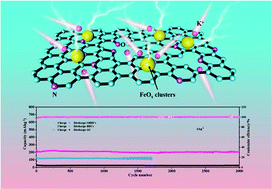Fe nanopowder-assisted fabrication of FeOx/porous carbon for boosting potassium-ion storage performance†
Abstract
The electrode materials of potassium ion storage system have attracted considerable attention given the promising prospect of a potassium ion system in large-scale electrochemical energy storage applications. Despite the excellent anode performance of metal oxides in Li+ and Na+ batteries, the study on their K+ storage performance is still rarely reported. In this study, we report a safe and low-cost strategy to prepare FeOx/N-doped carbons by using NaHCO3 and Fe nanopowder. Benefiting from the oxidation of Fe to Fe3O4, an interesting “one stone, two birds” role of the Fe powder can be identified in the heating process. As a reduction agent, the Fe powder can consume the excess oxygen in the bio-massed carbon framework, facilitating the formation of short-range-ordered domains in the biomass-derived carbon materials (FeOx@GBHCs). Moreover, the close combination of oxidization products (Fe3O4 particles) and carbon matrix leads to numerous FeOx clusters grafted on the surface of the carbon framework via the strong C–O–Fe binding. Therefore, the resultant FeOx/porous carbon exhibits a high reversible capacity of 410 mA h g−1 and an excellent cycling capability. The assembled FeOx@GBHCs//AC potassium-ion hybrid supercapacitor delivers a high energy density of 133 W h kg−1 at a power density of 700 W kg−1, demonstrating a potential prospect of metal oxides in boosting the potassium ion storage performance.



 Please wait while we load your content...
Please wait while we load your content...